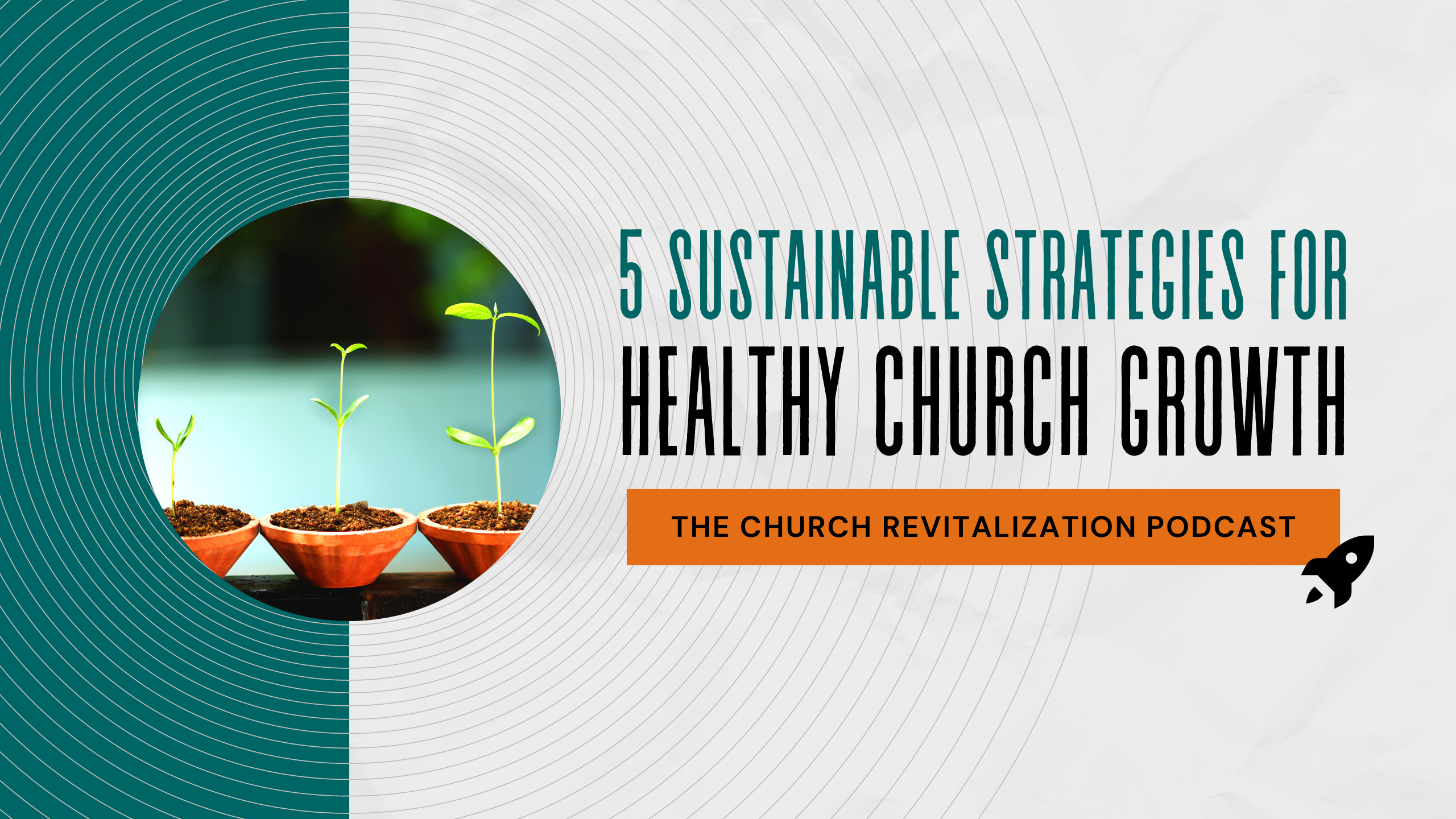The Church Revitalization Podcast – Episode 115
Healthy, sustainable church growth requires focusing your energy on the right things.
Did you know that zookeepers have a hard time maintaining the panda population? It’s true. Pandas don’t appear to have much of an instinct to reproduce; it’s almost as if they want to go extinct. This bizarre hesitancy to make more pandas is leading to their rapid decline.
It’s an odd analogy, I know. But Western churches are increasingly hesitant to focus on reproducing disciples. There is an aversion to even saying the words “church growth,” and this hesitancy is one of the factors contributing to the decline of the Church.
For many pastors church growth is a taboo topic; it’s uncouth to talk about growing your church and reaching more people. Secretly, most pastors would like to see more people in the pews on Sundays–but they often won’t talk about it with their congregations or even admit it out loud. Some of the negativity around church growth is understandable. After all, focusing on getting large numbers of people in the door is often a fast-track to ego-driven ministry. Churches also assume that “church growth” means “doing church” in a very specific way (read: fog machines, rock music, and moving lights).
But church growth in and of itself isn’t bad–and shouldn’t be taboo! And church growth is not the same as a dictate for a particular brand or style of church. Notably, Jesus’ command to make disciples is inherently a call to grow the church. Therefore, every church should be in the business of sharing the gospel and growing the Kingdom. You can focus on healthy church growth without getting your ego involved and through a variety of styles and approaches to ministry. But without a relentless focus on replicating disciples, your church will go extinct.
Healthy, sustainable church growth requires focusing your energy on the right things. Below, you’ll learn five key strategies your church can use to sustain healthy church growth.
Subscribe below to never miss an episode.
[podcast_subscribe id=”8838″]
Know Where You’re Going
Your church cannot grow if you do not have a clear God-given direction for your future. God gave the Israelites a clear vision of bringing them into the Promised Land. When the people abandoned that vision in the wilderness, God punished them by preventing a generation from entering the promise. Joshua and Caleb understood the vision and were willing to take risks for the sake of God’s promise.
Likewise, Paul had a vision to take the Gospel to Rome. He wanted to meet the believers there and grow the Church in Rome. He was willing to go as a prisoner, endure shipwreck and hardship, so long as he could continue his mission to Rome.
In the same way, your church must have a unified understanding of what God is calling you to do. Without it, your church will have conflict when trouble comes. You will get stuck in a rut, and fail to be fruitful. God has a unique plan and vision for your church, and great leaders communicate and unite their congregations around that common vision.
Continually Iterate Your Best Ministries
Growing churches have a holy discontent with the status quo. They assume that there is always margin for improvement–even in their most “successful” ministries. You must take on the attitude that there is always room for even 5% of improvement, and be dogmatic about identifying imperfections (and then making the needed changes).
Pull out the smartphone from your pocket. Odds are that the model in your hands isn’t significantly different from the model that came out the year before yours. And the model that came after it won’t be much different either. In fact, tech reviewers often complain when new phones come out that “this update isn’t worth it.” But if you compare the phone in your hand right now from the one that came out ten years ago… there is no comparison!
In the same way, when you make the commitment to continually iterate and improve upon your ministries, you might not notice much difference between this month and last month or this year and next year. But when you look back in three or five years, the difference should be astounding–and for the better!
The reality is that the status quo is a myth. You’re either actively putting energy into a ministry so that it can grow, or the ministry is falling victim to the Third Law of Thermodynamics. The ministry will eventually become a casualty of entropy and inertia.
If you look around and nothing is notably different (and better) than three years ago, start reversing that trend today.
Relentlessly Eliminate Discipleship Distractions
While on the one hand, you need to continually improve the things that are driving discipleship results, it’s equally important that you eliminate programs, ministries, and events that distract from discipleship. Most churches start ministries with good intentions. While not every plan is particularly effective or strategic, the intentions are often well-placed. But even once thriving and discipleship-focused ministries can lose their effectiveness over time.
At the Malphurs Group, we frequently preach to churches that we need to be married to the discipleship process – not the discipleship programs. Therefore, whenever a ministry, program, or event no longer achieves its stated goal, we need to get rid of it.
Your church has a limited amount of resources. The obvious ones are volunteer resources and financial resources. But attention is also a resource. People can only pay attention to so many things, and if you spend that limited attention on events or programs that don’t move you towards your mission and vision, it’s a waste.
Growing churches value their resources and relentlessly eliminate wasting them.
Build Systems of Care
Growing churches understand the vital need for pastoral care. In fact, there is a false assumption that only “small churches” can do pastoral care well and that “big churches” are inherently places where people fall into the cracks. The more complicated truth is that people can fail to be properly known and cared for in any size church. The difference is not the size of the church but the quality of the system of care.
Pastors are limited in their time and capacity to care for people. A healthy, growing church will implement systems for identifying needs and a triage process that enables lower-priority needs (like a minor illness) to one level of care and higher-priority needs (like the tragic death of a teenager) to the highest level of care. The uncomfortable truth is that the pastor cannot care for every single need. That’s true in a church of 100 or 1,000. The sooner you embrace that reality and implement a competent system of care, the better you’ll be at truly caring for people.
There are cultural expectations that the senior pastor has to conduct every hospital visit, wedding, and funeral. But this is unsustainable, and every pastor with more than a few years of ministry can attest to the unrealistic expectations people often have. Therefore, by developing and communicating your system of care to your people, you can begin to shift expectations and build a community where everyone can be known, loved, and cared for.
Stack the Deck
Your vision, strategies, and plans can all be great on paper. But at the end of the day, it all hinges on leadership. If your church is relying on too few leaders to accomplish too many things, you’ll never experience sustainable growth. Churches that grow have a deep bench. Therefore, you need to stack the deck in your favor by recruiting and developing more and better leaders.
In fact, we recommend that most pastors build their schedule so that they can dedicate about a third of their week to leadership development. It’s that important! Jesus understood that the long-term success of His message didn’t depend on the size of the crowd He preached to but on the quality of the leaders who followed Him. The growth of the movement hinged on the capacity of the leaders Jesus developed. The same is true for you.
In our Leadership Pipeline process, we teach churches how to create a system for recruiting leaders and helping them be more effective. Churches that go through that process frequently remark that the paradigm shift towards leadership development is the single most impactful thing they have done to influence church growth. It’s no wonder! God has called every believer into ministry, and it’s the role of leaders to focus on equipping the saints to live out their calling.
Church growth isn’t about nickels and noses. It’s not about fog machines and cool lights. Church growth isn’t about fueling your ego. But God is calling every church to grow because every church is called to go and make disciples.
If you want to experience sustainable and healthy church growth, lean into these five principles. Just do the next right thing. You’ll be surprised how far you come in the months and years to come.
BONUS: Get a free Team Discussion Guide in the video description on YouTube.

Scott Ball is the Vice President and a Lead Guide with The Malphurs Group. He lives in East Tennessee with his wife and two children. (Email Scott).


